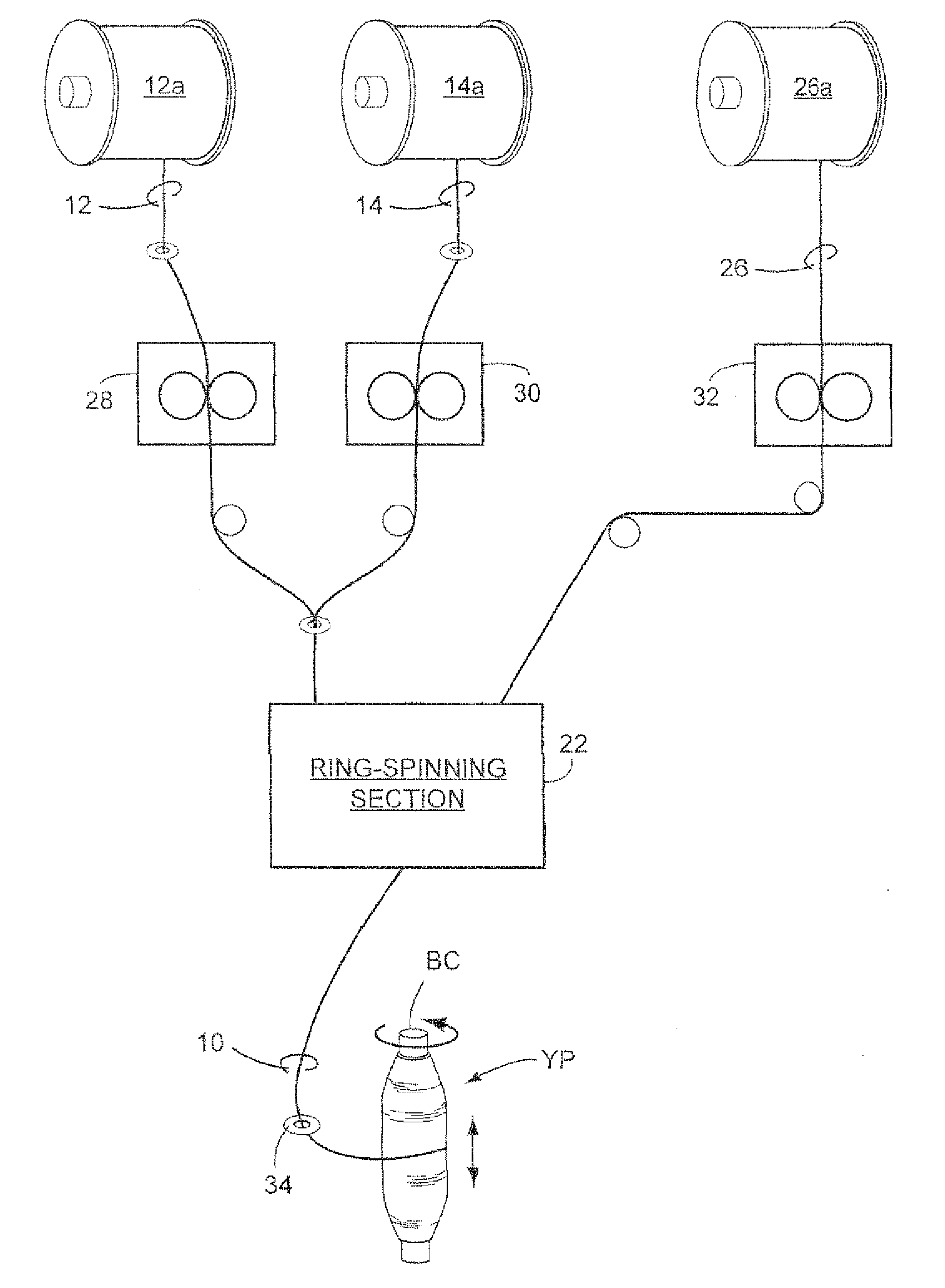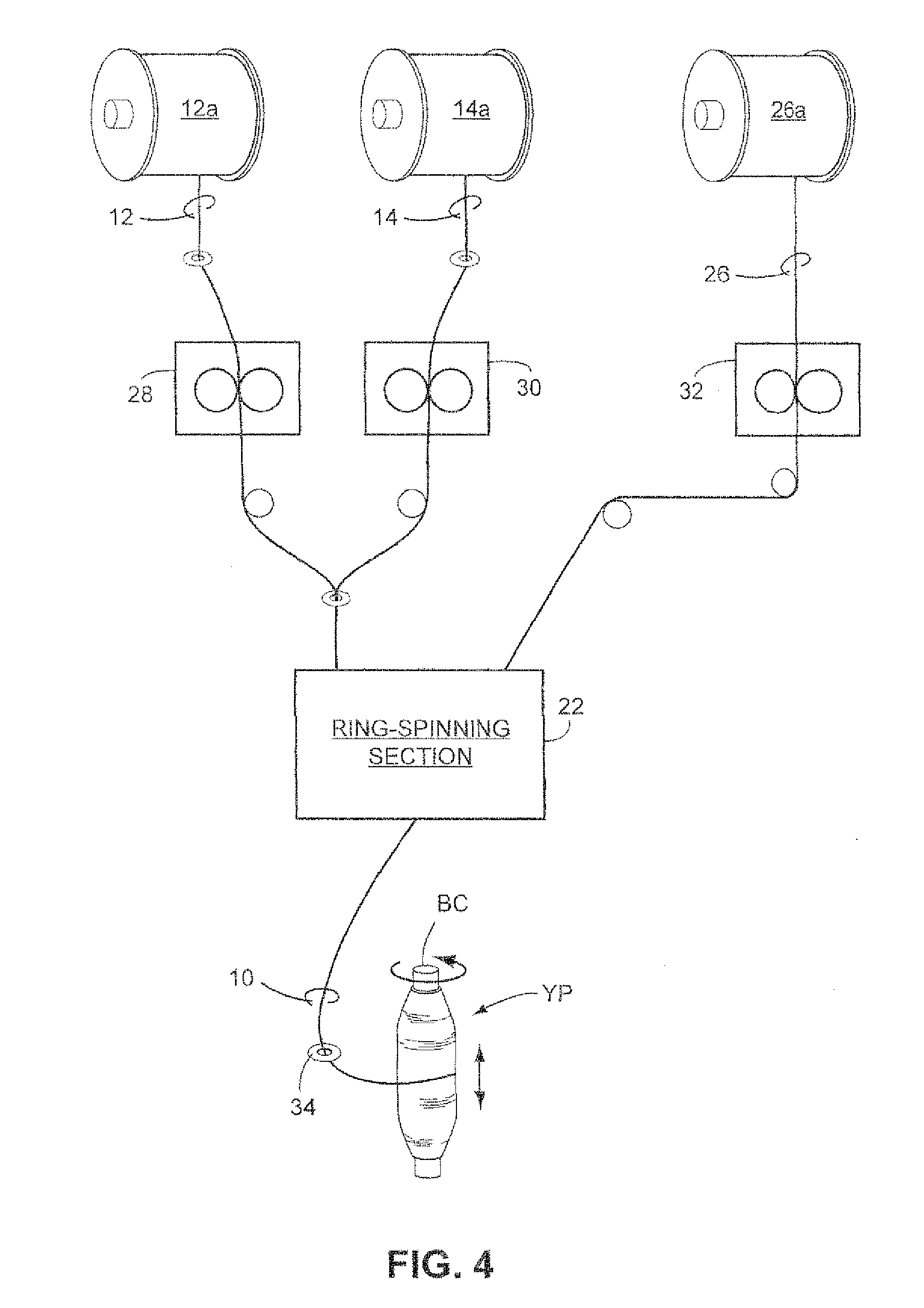Elastic composite yarns and woven fabrics made therefrom, and methods and apparatus for making the same
- Summary
- Abstract
- Description
- Claims
- Application Information
AI Technical Summary
Benefits of technology
Problems solved by technology
Method used
Image
Examples
example 1
[0048]A composite core yarn was made of 70 denier spandex filament commercially obtained from RadicciSpandex Corporation drafted at 3.1 and a 70 denier stretch textured polyester filament (Jan. 70, 1968) commercially obtained from Unifi, Inc. drafted at 1.0. The composite yarn was spun on a Marzoli ring spinning machine equipped with an extra hanger and tension controllers for the composite core yarn. A hank roving size of 0.50 was used and drafted sufficiently to yield a total yarn count of 14 / 1. The resulting composite yarn was woven on an X-3 weaving machine to create a vintage selvage denim with stretch. The reed density of 14.25 (57 ends in reed) was used instead of the normal 16.5. The resulting fabric was desized, mercerized, and heat set to a width of 30 inches on a Monforts tenter range. The resulting denim fabric stretch was 18% and the elastic recovery was 96.9% according to ASTM D3107.
[0049]A comparison fabric was made using a 14 / 1 regular core spun yarn containing only ...
example 2
[0050]A denim fabric was woven using yarns of Example 1 as weft on a Sulzer rapier wide loom. This denim was made with one pick of the 14 / 1 multi-core yarn followed by one pick of 14 / 1 normal core spun with 40 denier spandex. This denim was made with 16.0 reed density (64 ends in reed). The fabric was desized and mercerized but not heat set. The resulting fabric had 29% stretch and a recovery of 96.0% based on ASTM D3107.
[0051]A comparison fabric was made using all picks of 14 / 1 normal core spun with 40 denier spandex. The comparison fabric had 25% stretch but only 95.3% recovery when tested according to ASTM 3107.
example 3
[0052]A 3 / 1 twill bi-directional stretch denim made with warp and weft comprised of multi-core yarns made with the apparatus described in Example 1. The core consisted of a 1 / 70 / 34 textured polyester continuous filament strand drafted at 1.00 to 1.02, and a 40 denier spandex elastomeric (RadicciSpandex Corporation) drafted at 3.1. The wrapping or sheath of the core spun yarn consisted of cotton fibers sufficient to provide a total weight of 7.5 / 1 Ne in warp and 14 / 1 Ne in weft. The warp yarn was woven at low density and the fill yarn was woven at 48 weft yarns per inch. After mercerization, heat setting, and finishing the final yarn density was 64×52 giving a fabric weight of 11.25 oz. per square yard. The stretch after heat setting was 11% in warp direction with 97% average recovery. The stretch in the weft direction was 22% with a recovery of 96%.
PUM
| Property | Measurement | Unit |
|---|---|---|
| Fraction | aaaaa | aaaaa |
| Ratio | aaaaa | aaaaa |
| Elasticity | aaaaa | aaaaa |
Abstract
Description
Claims
Application Information
 Login to View More
Login to View More - R&D
- Intellectual Property
- Life Sciences
- Materials
- Tech Scout
- Unparalleled Data Quality
- Higher Quality Content
- 60% Fewer Hallucinations
Browse by: Latest US Patents, China's latest patents, Technical Efficacy Thesaurus, Application Domain, Technology Topic, Popular Technical Reports.
© 2025 PatSnap. All rights reserved.Legal|Privacy policy|Modern Slavery Act Transparency Statement|Sitemap|About US| Contact US: help@patsnap.com



